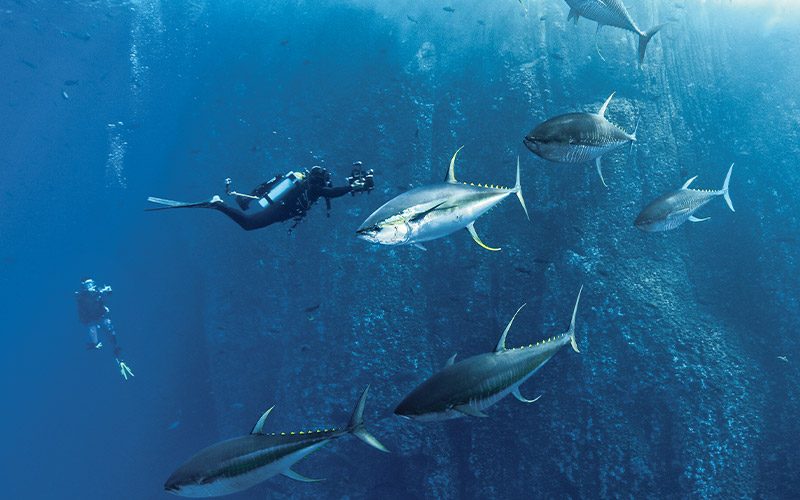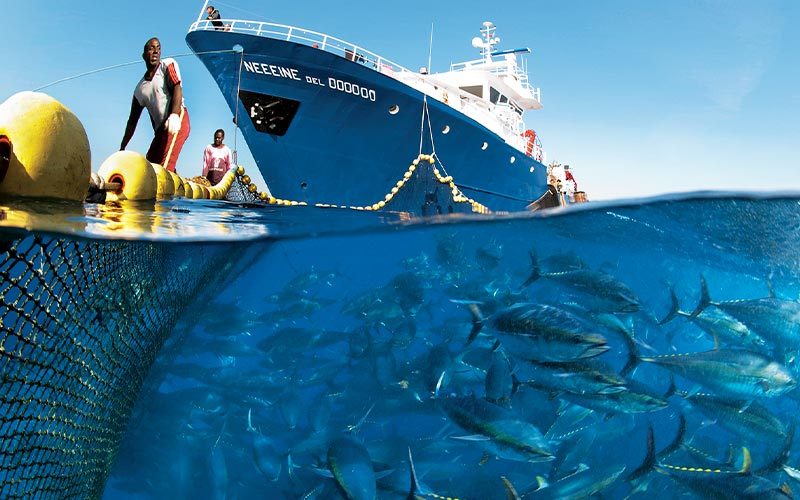What’s the first thing that comes to mind when you hear the word “tuna”?
Is it bland, pinkish sandwich filling? Crimson slivers of velvety sashimi? Or perhaps a cartoon fish with a hat, glasses and a Brooklyn accent? If so, don’t worry — you are not alone. Decades of seafood marketing and cultural perception are at work here. But after years of being treated like the “chicken of the sea,” it’s about time tuna got the respect they deserve.
Athletes of the Sea
Let’s clarify one thing up front: Tuna are not ordinary fish. They are athletic freaks of nature, built for raw power, speed and endurance. They can withstand intense cold, dive to crushing depths and swim at speeds approaching 50 miles per hour. The largest species can grow to staggering dimensions: sometimes 10 feet or more in length. The world-record Atlantic bluefin tuna, reeled in off Nova Scotia in 1979, weighed 1,496 pounds and ranks high on the list of the biggest fish ever caught.
“They are the pinnacle of bony fish evolution — they’re the ‘super fish,'” said Barbara Block, a marine biologist at Stanford University, who is one of the world’s leading experts on bluefin tuna.
Block and her team have tagged and tracked more than 2,000 Atlantic and Pacific bluefin during her career. Their research has revealed much about the epic migrations undertaken by these extraordinary fish, such as the Pacific bluefin that swam from California to Japan and back — more than 10,000 miles — in the span of just five months in 2003.
Similar to lions and wolves, tuna are apex predators that travel long distances in search of prey, tend to hunt in groups (schools) and play a key role in regulating the ocean food web. While it may seem strange to compare the main ingredients in Fancy Feast with such iconic land mammals, there’s more truth in the comparison than you might suspect.

Meeting The Thunnini Tribue
So what exactly makes a tuna a tuna? Taxonomically speaking, tunas are predatory ocean-going fish belonging to a “tribe” called Thunnini, a subgroup of the mackerel family (Scombridae). The tribe encompasses the eight “true tunas” of the genus Thunnus — albacore, bigeye, longtail, yellowfin, blackfin and three species of bluefin — and seven other tuna species including skipjack, slender and little tunny.
All tunas, from the smaller bullet and frigate species to the giant bluefin, have streamlined, spindle-shaped bodies with a crescent-shaped tail fin, two dorsal fins, pectoral fins that can be tucked in for high-speed swimming and triangular “finlets” running along the upper and lower sides of the tail. Skin coloration varies from species to species but generally fades from metallic blue on top to silvery-white underneath, often with a splash of yellow accents.
Peeking under the hood, we find one of the most impressive pieces of biological machinery in the entire ocean. “When you look at a tuna, you’re looking at an animal that’s built for very, very high performance,” said Randy Kochevar, a marine biologist who works with Block at Stanford University’s Hopkins Marine Station.
Indeed, every aspect of tuna physiology seems to push the limits of what’s physically possible, from ultra-high-efficiency gills to a massive heart that can beat up to 200 times per minute. What makes these animals truly special is not just their size, speed or strength but the unique evolutionary adaptations, honed over hundreds of millions of years, that make such incredible performance possible.
Just Keeping Swimming — Or Else
The name Thunnus comes from the ancient Greek for “to dart” or “to rush” — an apt descriptor for these efficient, powerful swimmers capable of tremendous bursts of acceleration. That power comes at a price though. With high oxygen demands and a muscular physique that’s denser than seawater, a tuna can never stop swimming during its lifetime.
Tuna require five to 10 times greater flow of water over their gills than most fishes, which they achieve by swimming with their mouths perpetually open, called “ram ventilation.” They fly through the water like fighter jets, their lack of buoyancy offset by lift generated by their pectoral fins. And, like an aircraft, if a tuna stops producing forward thrust, it will sink like a stone.
To keep themselves in perpetual forward motion, tuna have evolved a compact swimming style consisting of short, powerful strokes of the tail with very little head movement. Bundles of deep red, oxygen-burning “slow-twitch” muscle running along the core of the fish enable them to sustain this unique form of locomotion over vast distances.
The “Wonderful Net”
All the constant swimming tuna are forced to do generates a lot of excess heat. For most fish, that energy would be lost, dissipated quickly into the colder surrounding seawater.
But, as we’ve established, tuna are not “most fish.” One of their remarkable evolutionary adaptations is the rete mirabile (Latin for “wonderful net”), a network of blood vessels that lets them retain body heat and use it to warm their muscles, brain and eyes above the ambient ocean temperature. Members of the genus Thunnus can even heat their stomachs to aid digestion after swallowing a meal of ocean-chilled seafood.
That’s right — tuna are endothermic, or “warm-blooded,” like humans. No other bony fish can claim that distinction. While their cold-blooded cousins are generally limited to a narrow range of temperatures, tuna can move freely around the globe through the dark depths and the sunlit shallows, the sweltering tropics and the frigid higher latitudes.
Different species inhabit various regions around the globe, with some favoring tropical latitudes (yellowfin, skipjack), while others prefer cooler regions (albacore, Atlantic bluefin, Pacific bluefin, southern bluefin). Bigeye in particular are champion divers, known to travel to depths of 3,300 feet or more in pursuit of food, making roller-coaster descents and ascents that would make a divemaster blanch.
A Wandering Life
Tuna don’t turn into these hulking, supercharged speed demons overnight. Almost all tuna species spawn in warm tropical regions, where their larvae start life floating with the currents and dining on zooplankton until they begin to resemble miniature versions of their parents.
They continue to grow rapidly as juveniles, shifting their focus to new prey as they get larger. Tuna are opportunistic feeders and will happily consume a wide variety of prey over the course of their lives depending on their age, location and season. A highly abridged list of tuna prey includes crustaceans, squids and countless small fish species such as anchovies, sardines, menhaden, hake and mackerel.
Groups of tuna will often attack bait balls — huge, swirling schools of smaller fish — sometimes working in concert with other predators such as dolphins and seabirds as they drive their prey into ever-tighter spaces. Think of it as an all-you-can-eat sushi buffet, except in this case it’s the sushi that’s stuffing its face.
As tuna approach adulthood, the life history varies dramatically among tuna species (and sometimes even within species). Some tunas stick closer to the coast, while others prefer deeper waters. Some never stray far from where they were born. Atlantic bluefin born in the Gulf of Mexico regularly migrate thousands of miles to the Mediterranean Sea, only to return to their birthplace to spawn many years later. “When you think about how they start their lives and are swept very quickly into the open ocean, the fact that they find their way back is truly remarkable,” said David Secor, a tuna biologist with the University of Maryland Center for Environmental Science.
Most tunas reach sexual maturity between two and five years of age, with the exception of the bluefin species, which can take anywhere from eight to 15 years to begin spawning. This topic has received considerable attention in recent years in light of widespread concern over the sustainability (or lack thereof) of tuna fisheries and the impact of overfishing on tuna populations around the globe.
Feeding Frenzy

Humans have been catching and eating tuna for thousands of years. In the Mediterranean Sea the earliest evidence of bluefin tuna fishing has been estimated at roughly 7,000 B.C., with large-scale trap fishing developed by the Phoenicians around 2,000 B.C. “Tuna built a lot of civilizations around the globe,” Block says. “It’s only recent generations that have begun to treat it like a commodity.”
Within the past hundred years or so, our craving for tuna in its many forms has ballooned into a full-blown addiction. Canned tuna, which debuted in the U.S. in 1903, succeeded in turning these proud fish into a bulk commodity that for decades reigned as the most popular seafood in America.
Then there’s the global market for bluefin meat, which is prized in sushi restaurants around the world (especially in Japan, where most top-quality bluefin ends up). Sold under names such as otoro and hon maguro, the rich, fatty flesh ranges in hue from soft pink to deep red, looking more like filet mignon than Filet-O-Fish. Bluefin can fetch astronomical prices at Tokyo fish markets; for example, a 489-pound specimen sold for a mind-boggling $1.78 million at auction in January 2013 — more than $3,600 per pound.
This gourmet feeding frenzy has been bad news for the future of bluefin populations, which continue to be overfished despite numerous scientific reports from academic institutions and conservation groups around the world warning that they are on the brink of collapse.
Back from the Brink?

There are some signs, however, that tuna’s fortunes could be changing for the better. Block said she is encouraged by recent efforts to influence governments and consumers to take pressure off the most heavily overfished species such as Atlantic bluefin, which by most estimates has declined by more than 70 percent across all populations since 1970. “I think the tide is changing quickly,” she said. “What we need to do is figure out how to produce the tuna that the world needs without depleting wild populations.”
Tuna aquaculture, or “ranching,” certainly has potential in that regard, although critics say current practices do little to alleviate overfishing and even create greater burden on tuna stocks. Block said she is hopeful that will change as the science and management continue to improve.
For now, though, conservation-minded consumers will want to steer clear of bluefin. And the next time you find yourself scarfing down a spicy tuna roll (almost certainly yellowfin or bigeye) or a tuna fish sandwich (albacore or skipjack), spare a moment to think about all the things that make these fish so amazing.
© Alert Diver — Q1 Winter 2014